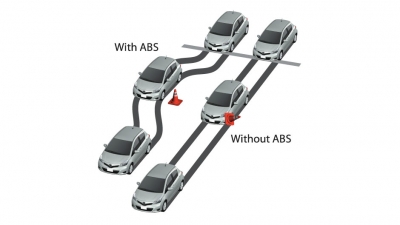
Most drivers have experienced the frightening moment when the wheels lock and the car slides uncontrollably toward the vehicle in front. Although drivers ate taught to leave a sufficient gap for braking, and to take extra care on wet or icy roads, the huge number of rear-end collisions every year is ample evidence they do not.
Skidding and sliding happen because the behaviour of a car changes rapidly when the wheels begin to lock. Up to a point, pressing the brake pedal harder produces greater deceleration. But once the wheels have locked, their grip on the road is lost, they begin to slide instead of turn, and the driver can no longer control the car’s direction. Panic follows, and the natural reaction is to stamp ever harder on the brake, which makes things worse.
Advanced driving manuals recommend cadence braking, in which the brake pedal is pumped up and down in quick succession to ensure that the wheels never lock. But, in practice, few drivers have the skill or experience to do this in an emergency.
Anti-lock brakes are designed to auto-mate the technique of cadence braking, taking the skill out of the hands and feet of the driver and entrusting it to a package of electronics and hydraulics. They consist of two parts: an electronic sensor that can detect how rapidly the wheels are decelerating, and a system for automatically controlling the hydraulic pressure on the brakes to achieve the best and safest deceleration.
The sensor consists of a slotted or toothed exciter disc attached to an axle or inside a brake drum. As the axle turns, each tooth and gap in this disc pass close to a monitor and generate a current, which varies according to the rate at which the disc is rotating.
The signals are interpreted by electronic circuits, which determine both the speed of the disc and the rate at which it is decelerating. If the disc is slowing down too rapidly and is about to lock, the circuits instruct the hydraulic controls to reduce brake pressure, preventing a skid. As the driver continues to press the brakes, pressure rises again, and the system repeats the operation until the vehicle has stopped. The system can produce up to 45 cadences a second, if required.
The details of how the electronic signals are used to control brake pressure depend on individual designs. Some of earliest non-skid brakes, in the 1960s, were fitted to trucks, which use air under pressure to activate their brakes. In these systems it is relatively simple to bleed off some of the air through a valve to reduce pressure. The air lost can easily be replaced by drawing on air stored under pressure in the vehicle.
The same simple arrangement cannot be applied to cars, which use hydraulic fluid. This is because there is little fluid in reserve, and also it would be both expensive and dangerous to spill bled-off hydraulic fluid all over the road. One alternative is to reduce pressure by briefly increasing the volume of the hydraulic system — with a piston arrangement, for example — and then to restore pressure again. Among the systems that have been developed are some that even allow sharp turns to take place safely during heavy braking.
Although anti-locking brakes were originally available only on the most expensive cars, they are increasingly becoming standard, or optional, on most new cars.
Picture Credit : Google

